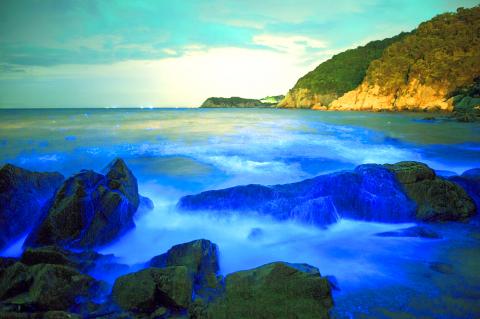Fluorescent sea sparkles, dubbed “blue tears,” that glow around the Matsu Islands of Lienchiang County are not caused by toxic algae and are not a sign of environmental deterioration, a National Taiwan Ocean University professor said on Sunday, challenging a recent study.
Chiang Kuo-ping (蔣國平) said that it cannot be established that the “blue tears” along Matsu’s beaches are associated with toxic algae because they do not drain oxygen from the surrounding waters and kill marine life in the process as stated in the study.
He said the single-celled Noctiluca scintillans, also known as dinoflagellates or sea sparkles, that generate the bioluminescence described as blue tears when disturbed, are non-toxic heterotrophs — organisms that cannot produce their own nutrients.

Photo courtesy of the Lienchiang County Government
In coastal ecosystems, they replace copepods — small crustaceans commonly found in aquatic communities — as the main consumers of phytoplankton and play the role of a “terminator” of single-cell algae called diatoms, which Chiang described as a normal phenomenon in marine ecosystems.
The toxic algae argument does not hold water along the coastlines of the Matsu Islands because the sea sparkles have not starved the water of oxygen or led to the death of marine life, he said.
The US study in the journal Geophysical Research Letters was conducted by people with expertise in studying satellite data and images rather by than ecological experts, he said.
The study by Hu Chuanmin, a professor of optical oceanography at the University of South Florida, was extensively covered by local media.
It argued that sea sparkles have become more abundant in recent years based on satellite images that have tracked their movement.
The study observed that from 2000 to 2003 when the Three Gorges Dam was being built on the Yangtze River and there was little water flow, there was only a small distribution of blue tears, but since construction had been completed and the water flow was restored to normal, the blue tears had steadily expanded.
While the reason for that cannot be determined for certain at present, it is likely related to the major release of pollution and agricultural runoff of nutrients from the Yangtze River into the East China Sea, the study said.
Explaining the study to the Live Science Web site, Hu said the sea sparkles are not toxic themselves, but when they eat, they usually choose toxic algae and in the process release ammonia and other chemicals that poison the water around them.
They also breathe oxygen until there is none left in the surrounding waters, making their growing numbers particularly troublesome, Hu was cited as saying by Live Science.
“The oxygen in the water is so low that many animals die,” he was quoted as saying.

Taipei and New Taipei City government officials are aiming to have the first phase of the Wanhua-Jungho-Shulin Mass Rapid Transit (MRT) line completed and opened by 2027, following the arrival of the first train set yesterday. The 22km-long Light Green Line would connect four densely populated districts in Taipei and New Taipei City: Wanhua (萬華), Jhonghe (中和), Tucheng (土城) and Shulin (樹林). The first phase of the project would connect Wanhua and Jhonghe districts, with Chiang Kai-shek Memorial Hall and Chukuang (莒光) being the terminal stations. The two municipalities jointly hosted a ceremony for the first train to be used

The Mainland Affairs Council (MAC) yesterday said it is fully aware of the situation following reports that the son of ousted Chinese politician Bo Xilai (薄熙來) has arrived in Taiwan and is to marry a Taiwanese. Local media reported that Bo Guagua (薄瓜瓜), son of the former member of the Political Bureau of the Central Committee of the Communist Party of China, is to marry the granddaughter of Luodong Poh-Ai Hospital founder Hsu Wen-cheng (許文政). The pair met when studying abroad and arranged to get married this year, with the wedding breakfast to be held at The One holiday resort in Hsinchu

Tropical Storm Usagi strengthened to a typhoon this morning and remains on track to brush past southeastern Taiwan between Friday and Sunday, the Central Weather Administration (CWA) said. The storm, which as of 8am was still 1,100km southeast of southern Taiwan, is currently expected to enter the Bashi Channel and then turn north, moving into waters southeast of Taiwan, the CWA said. Because of its rapid speed — 28kph as of 8am — a sea warning for the storm could be issued tonight, rather than tomorrow, as previously forecast, the CWA said. In terms of its impact, Usagi is to bring scattered or

An orange gas cloud that leaked from a waste management plant yesterday morning in Taoyuan’s Guanyin District (觀音) was likely caused by acidic waste, authorities said, adding that it posed no immediate harm. The leak occurred at a plant in the district’s Environmental Science and Technology Park at about 7am, the Taoyuan Fire Department said. Firefighters discovered a cloud of unidentified orange gas leaking from a waste tank when they arrived on the site, it said, adding that they put on Level A chemical protection before entering the building. After finding there was no continuous leak, the department worked with the city’s Department